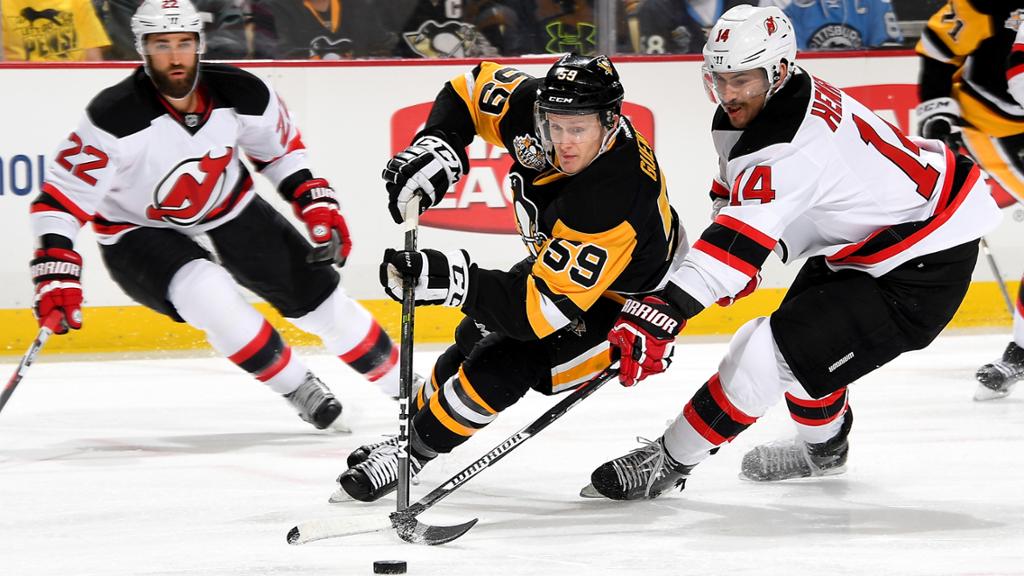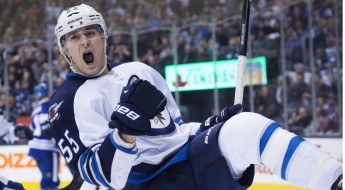What if Jake Guentzel is actually a star?

Jake Guentzel is one of those 3rd round picks that looks good right from the get-go, then looks incredible four years later. His rise to 13 goals in last year’s playoffs has been as picture perfect as a 3rd round selection gets.
After a promising show with the Sioux City Muskateers in the USHL, Guentzel earned himself the 77th selection in the 2013 NHL draft. Since then, he’s done it perfectly: Play three years of college, dominate by the end, and take a stab at professional hockey.
Guentzel was pretty legit before making the NHL
The only point of comparison we have for Jake Guentzel while not surrounded by a star studded line up is before he made the big leagues. His numbers are pretty darn impressive.
Guentzel’s third and final year of college saw him rack up 19 goals and 27 assists in just 35 games – a 45 goal, 63 assist pace over 82 games. He jumped straight to the AHL to finish the 2015-16 season, and showed us all his penchant for playoff performance, with 5 goals and 14 points in 10 games.
The 2016-17 season saw him destined for his full year in the pros – and he dominated the American League, posting 21 goals and 21 assists in just 33 games – a 52 goal, 52 assist pace over 82 games. Guentzel was clearly destined for the NHL, flying under the radar as a promising Penguins prospect.
The NHL was all that was left.
Excellent numbers with elite talent
Over his 40 regular season games as a Pittsburgh Penguin last year, he scored 16 goals and 17 assists, or a 32-goal, 66-point pace over 82 games. It’s not always easy to sustain those numbers over a longer sample, but that is excellent top-six production.
Then he follows it up with 13 goals in 25 playoff games en route to a Stanley Cup. What to think about that?
Well, the easy assumption (and I was guilty of it), is that it’s because of Crosby, or it’s because of Malkin and Kessel. And those A+ linemates absolutely have played a factor. But what we’re trying to get at here is that Guentzel was blazing a pretty impressive trail before he ever played with those folks. At 22, he chewed up the AHL, then jumped straight into a scoring role in the NHL.
We’ve seen Chris Kunitz, Pascal Dupuis, and more recently Conor Sheary produce way above their perceived value alongside Malkin and Croz. But do a bit of digging, and you find Guentzel is a perfectly legitimate scorer without them – all of his impressive college and AHL numbers were obviously done without his Pittsburgh teammates.
Which brings us back to our original question.
What if he’s a star?
Given the Pens already have three stars, Crosby, Malkin, and Kessel, it’s almost ludicrous to consider the addition of another. But what if? Well, the Chicago Blackhawks were a great example of how well teams can operate with four top line forwards.
We dug into the offensive composition of the Blackhawks’ remarkable run of three Stanley Cups in six years. Based on how the ‘Hawks did it, here’s a general summary of what is required to compete long-term for Stanley Cups.
- Three franchise forwards and a top line winger (Jonathan Toews, Patrick Kane, Marian Hossa, Patrick Sharp)
- A checking center (Antoine Vermette), and an offensive center (Brad Richards) to round out their top-3 centermen
- Cheap, capable homegrown depth that can provide offense to the team’s elite core (Teuvo Teravainen, Andrew Shaw, Brandon Saad)
Pittsburgh looks to have at least that, and then some.
- Sidney Crosby, Evgeni Malkin, and Phil Kessel are all franchise players, and you can count Patric Hornqvist as Pittsburgh’s “Patrick Sharp”. A top line contributor, but not a star. Based on Crosby and Malkin alone, you could already say the Penguins are ahead of the ‘Hawks – no disrespect to Toews and Kane.
- Since they lost both Nick Bonino and Matt Cullen this past offseason, the Pens are admittedly weak down the middle beyond Croz/Malkin. But I guarantee they can add a third line center at the trade deadline. No long-term problems there.
- They certainly have cheap, capable, home grown depth. The Penguins have recently retooled here, and have quality youngsters to rotate among their top-6 forwards. Jake Guentzel, Conor Sheary, and Bryan Rust all qualify (and possibly Daniel Sprong down the road).
Now that we’re on the same page as to what’s required to compete for multiple Stanley Cups, we go back to our original question. What if Jake Guentzel is 30 or 35-goal scorer on his own? Regardless of world class linemates?
Then Pittsburgh will own two world class centermen, have a top duo of Phil Kessel and Jake Guentzel to rotate along their wings, and the Penguins will possess four franchise forwards – four elite options to base an attack with. Most teams don’t even have two.
That core will mean it’s not just possible for Crosby and Co. to win a fourth Stanley Cup, but it’s almost likely they will. The Penguins’ Stanley Cup window is obviously wide open given they just won two in a row. But if they didn’t have a new wave of Penguins on the rise – led by Jake Guentzel and supported by Conor Sheary, there would be no hope that they would possess the required depth to continue their Stanley Cup march.
Thanks to some great drafting and developing though, Pittsburgh’s supporting cast is not only healthy, but elite. And elite cores complemented by an elite supporting cast is how teams make it to the Stanley Cup Finals.
If the Penguins can continue to fill holes at the trade deadline effectively, it could be quite some time until we see a new favorite come out of the Eastern Conference.
In the meantime, Jake Guentzel might just be an overrated youngster riding the coattails of the greatest one-two punch in recent history. But his road to the big league suggests he could be pretty darn impressive on his own.



